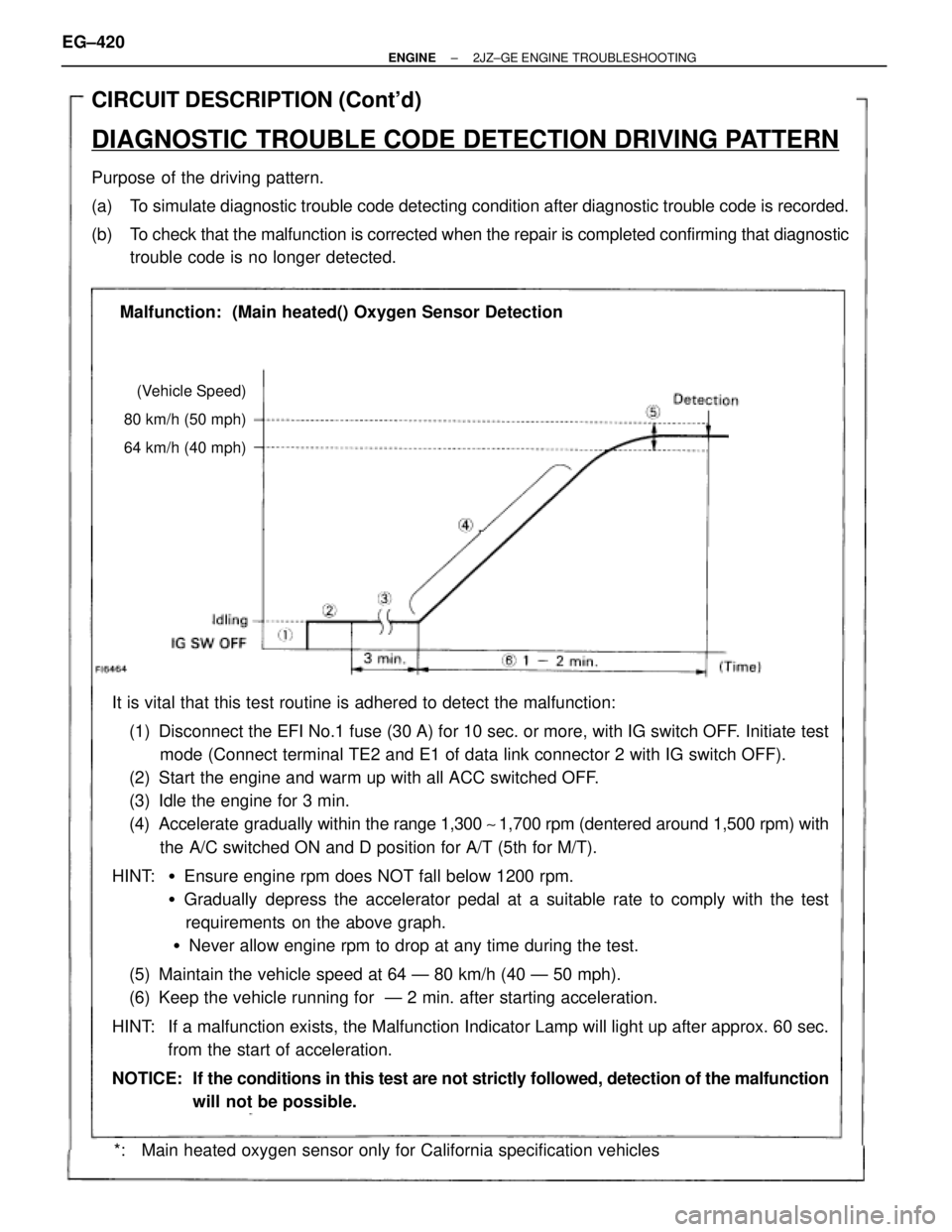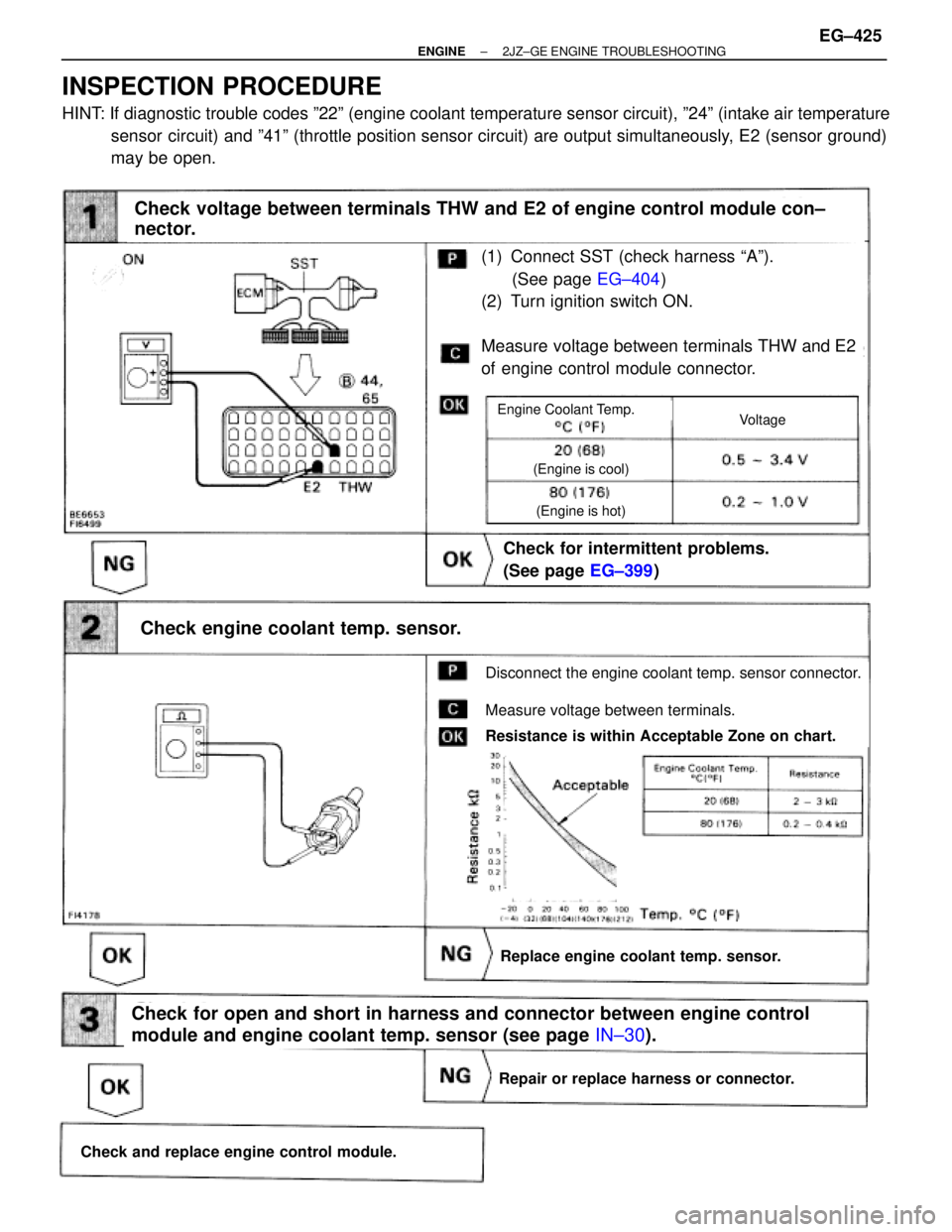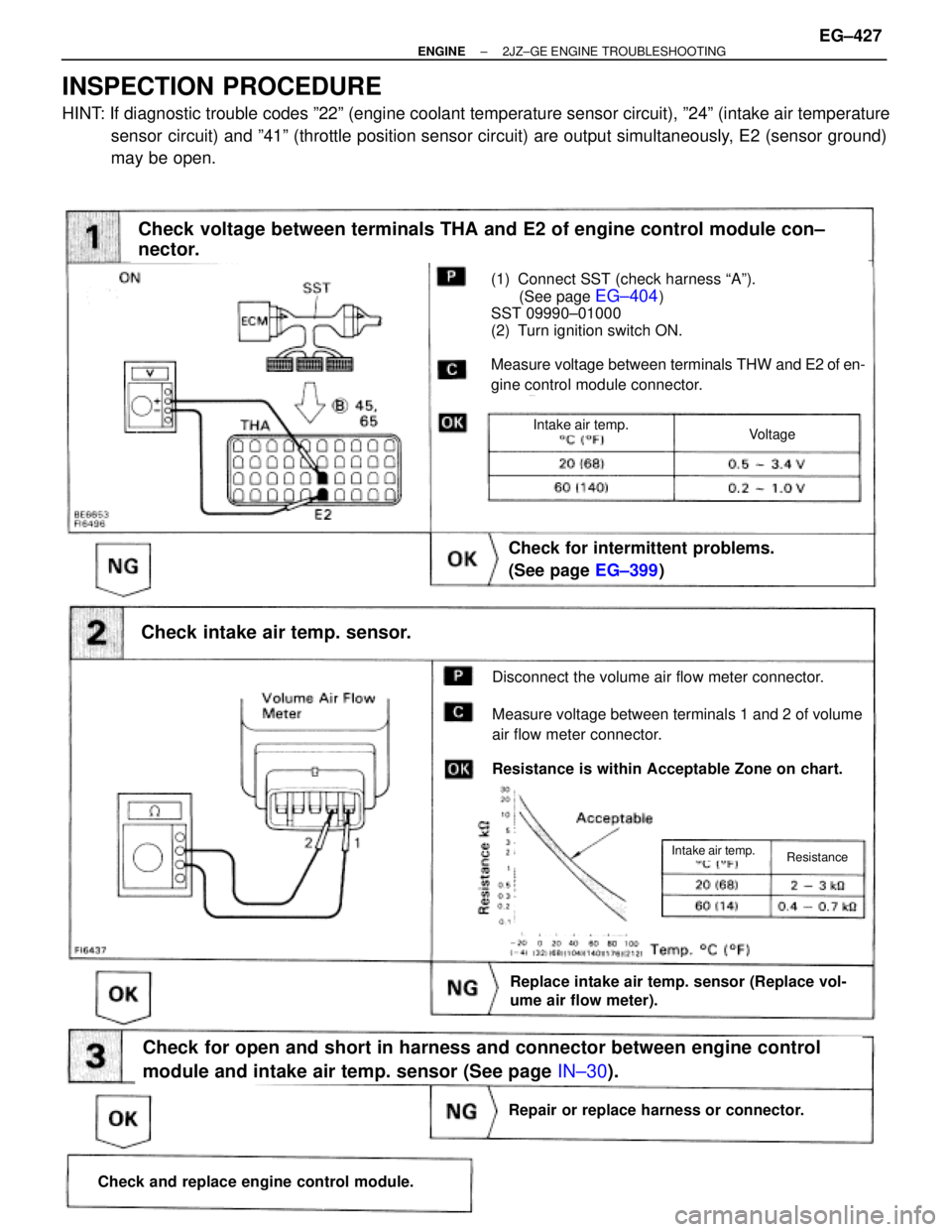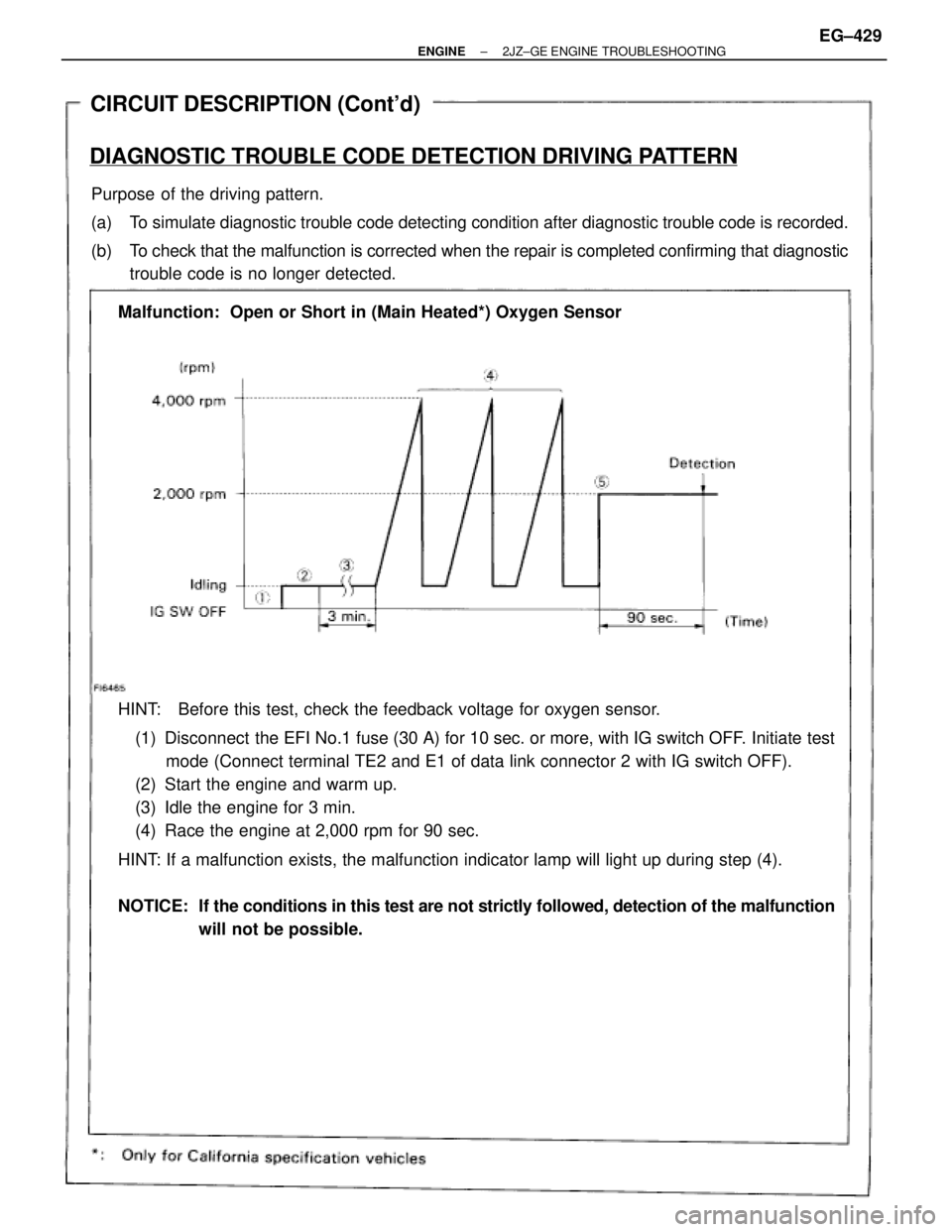Page 173 of 878
Disconnect igniter connector and check voltage between terminal IGT of engine
control module connector and body ground.
Check for open and short in harness and connector in IGT signal circuit be-
tween engine control module and igniter (See page
IN±30).
Replace igniter.
Repair or replace harness or connector.
Check and replace engine control module.
Disconnect igniter connector.
Measure voltage between terminal IGT of engine
control module connector and body ground when
engine is cranked.
Voltage: 0.5 Ð 1.0 V
(Neither 0 V nor 5 V)
�During cranking or idling, check waveforms between
terminal IGT and E1 of engine control module.
HINT: The correct rectangular waveforms are as shown.
INSPECTION USING OSCILLOSCOPE
± ENGINE2JZ±GE ENGINE TROUBLESHOOTINGEG±417
Page 176 of 878

CIRCUIT DESCRIPTION (Cont'd)
DIAGNOSTIC TROUBLE CODE DETECTION DRIVING PATTERN
Purpose of the driving pattern.
(a) To simulate diagnostic trouble code detecting condition after diagnostic trouble code is recorded.
(b) To check that the malfunction is corrected when the repair is completed confirming that diagnostic
trouble code is no longer detected.
Malfunction: (Main heated() Oxygen Sensor Detection
(Vehicle Speed)
80 km/h (50 mph)
64 km/h (40 mph)
It is vital that this test routine is adhered to detect the malfunction:
(1) Disconnect the EFI No.1 fuse (30 A) for 10 sec. or more, with IG switch OFF. Initiate test
mode (Connect terminal TE2 and E1 of data link connector 2 with IG switch OFF).
(2) Start the engine and warm up with all ACC switched OFF.
(3) Idle the engine for 3 min.
(4) Accelerate gradually within the range 1,300 ~ 1,700 rpm (dentered around 1,500 rpm) with
the A/C switched ON and D position for A/T (5th for M/T).
HINT: �Ensure engine rpm does NOT fall below 1200 rpm.
�Gradually depress the accelerator pedal at a suitable rate to comply with the test
requirements on the above graph.
�Never allow engine rpm to drop at any time during the test.
(5) Maintain the vehicle speed at 64 Ð 80 km/h (40 Ð 50 mph).
(6) Keep the vehicle running for Ð 2 min. after starting acceleration.
HINT: If a malfunction exists, the Malfunction Indicator Lamp will light up after approx. 60 sec.
from the start of acceleration.
NOTICE: If the conditions in this test are not strictly followed, detection of the malfunction
will not be possible.
*: Main heated oxygen sensor only for California specification vehicles EG±420
± ENGINE2JZ±GE ENGINE TROUBLESHOOTING
Page 178 of 878
INSPECTION PROCEDURE (Only for California specification vehicles)
HINT: If diagnostic trouble code º21º is output, check the main heated oxygen sensor (Fr) circuit.
If diagnostic trouble code º28º is output, check the main heated oxygen sensor (Rr) circuit.
Check voltage between terminals HT1, HT2 of engine control module
connector and body ground.
Connect SST (check harness ªAº).
See page EG±404)
SST 09990±01000
Measure voltage between terminals HT1, HT2 of engine
control module connector and body ground.
Voltage: 9 Ð 14 V
Go to step
Check main heated oxygen sensor heater.
Disconnect main heated oxygen sensor connector.
Measure resistance between terminals 1 and 2 of main
heated oxygen sensor connector.
Resistance: 11 Ð 16 � at 20°C (68°F)
Replace main heated oxygen sensor.
Check and repair harness or connector between main
relay and main heated oxygen sensor, main heated oxy-
gen sensor and engine control module.
EG±422± ENGINE2JZ±GE ENGINE TROUBLESHOOTING
Page 179 of 878
Check voltage between terminals HT1, HT2 of engine control module
connector and body ground.
INSPECTION USING OSCILLOSCOPE
Replace main heated oxygen sensor.*
Check and replace engine control module.
*: It is probable the oxygen sensor has deteriorated.
Usually, this cannot be confirmed by visual inspec±
tion.
Warm up engine to normal operating temperature.
Measure voltage between terminals HT1, HT2 of
engine control module connector and body ground.
when engine is idling and racing at 4,000 rpm.
In the 4,000 rpm racing check, continue engine rac-
ing at 4,000 rpm for approx. 20 seconds or more.
�With the engine racing (4,000 rpm) measure wave±
form between terminals OX1, OX2 and E1 of engine
control module.
HINT: The correct waveform is as shown, oscillating be
tween approx. 0.1 V nd 0.9 V
If the oxygen sensor has deteriorated, the ampli±
tude of the voltage will be reduced as shown on the
left.
± ENGINE2JZ±GE ENGINE TROUBLESHOOTINGEG±423
Page 181 of 878

(See page EG±404)
(1) Connect SST (check harness ªAº).
(See page EG±404)
(2) Turn ignition switch ON.
Measure voltage between terminals THW and E2
of engine control module connector.
Check for intermittent problems.
(See page EG±399)
Check engine coolant temp. sensor.
Replace engine coolant temp. sensor.
Repair or replace harness or connector.
Check and replace engine control module.
Check for open and short in harness and connector between engine control
module and engine coolant temp. sensor (see page IN±30).
Disconnect the engine coolant temp. sensor connector.
Measure voltage between terminals.
Resistance is within Acceptable Zone on chart.
Check voltage between terminals THW and E2 of engine control module con±
nector.
VoltageEngine Coolant Temp.
(Engine is cool)
(Engine is hot)
INSPECTION PROCEDURE
HINT: If diagnostic trouble codes º22º (engine coolant temperature sensor circuit), º24º (intake air temperature
sensor circuit) and º41º (throttle position sensor circuit) are output simultaneously, E2 (sensor ground)
may be open.
± ENGINE2JZ±GE ENGINE TROUBLESHOOTINGEG±425
Page 183 of 878

(See page EG±404)
(1) Connect SST (check harness ªAº).
(See page
EG±404)
SST 09990±01000
(2) Turn ignition switch ON.
Measure voltage between terminals THW and E2 of en-
gine control module connector.
Check for intermittent problems.
(See page EG±399)
Check intake air temp. sensor.
Disconnect the volume air flow meter connector.
Measure voltage between terminals 1 and 2 of volume
air flow meter connector.
Resistance is within Acceptable Zone on chart.
Check voltage between terminals THA and E2 of engine control module con±
nector.
Replace intake air temp. sensor (Replace vol-
ume air flow meter).
Check for open and short in harness and connector between engine control
module and intake air temp. sensor (See page IN±30).
Repair or replace harness or connector.
Check and replace engine control module.
VoltageIntake air temp.
ResistanceIntake air temp.
INSPECTION PROCEDURE
HINT: If diagnostic trouble codes º22º (engine coolant temperature sensor circuit), º24º (intake air temperature
sensor circuit) and º41º (throttle position sensor circuit) are output simultaneously, E2 (sensor ground)
may be open.
± ENGINE2JZ±GE ENGINE TROUBLESHOOTINGEG±427
Page 185 of 878

CIRCUIT DESCRIPTION (Cont'd)
DIAGNOSTIC TROUBLE CODE DETECTION DRIVING PATTERN
Purpose of the driving pattern.
(a) To simulate diagnostic trouble code detecting condition after diagnostic trouble code is recorded.
(b) To check that the malfunction is corrected when the repair is completed confirming that diagnostic
trouble code is no longer detected.
Malfunction: Open or Short in (Main Heated*) Oxygen Sensor
HINT: Before this test, check the feedback voltage for oxygen sensor.
(1) Disconnect the EFI No.1 fuse (30 A) for 10 sec. or more, with IG switch OFF. Initiate test
mode (Connect terminal TE2 and E1 of data link connector 2 with IG switch OFF).
(2) Start the engine and warm up.
(3) Idle the engine for 3 min.
(4) Race the engine at 2,000 rpm for 90 sec.
HINT: If a malfunction exists, the malfunction indicator lamp will light up during step (4).
NOTICE: If the conditions in this test are not strictly followed, detection of the malfunction
will not be possible.
± ENGINE2JZ±GE ENGINE TROUBLESHOOTINGEG±429
Page 186 of 878

See page
EG±421
(1) Disconnect the EFI No.1 fuse (30A) for 10 sec. or more, with IG switch OFF.
Initiate test mode (Connect terminal TE2 and E1 of data link connector 2
with IG switch OFF).
(2) Start the engine and warm up with all ACC switched OFF.
(3) Idle the engine for 5 min.
(After the engine is started, do not depress the accelerator pedal.)
(4) If the malfunction is not detected during idling, racing the engine without any load at
approx. 2,000 rpm for 60 sec.
HINT: If a malfunction exists, the malfunction indicator lamp will light up during the 5 min. idling
period or within 60 sec. of starting racing.
NOTICE: If the conditions in this test are not strictly followed, detection of the malfunction
will not be possible.
CIRCUIT DESCRIPTION (Cont'd)
DIAGNOSTIC TROUBLE CODE DETECTION DRIVING PATTERN
Purpose of the driving pattern.
(a) To simulate diagnostic trouble code detecting condition after diagnostic trouble code is recorded.
(b) To check that the malfunction is corrected when the repair is completed confirming that diagnostic
trouble code is no longer detected.
Malfunction: Open or Short in Injector circuit, Injector Leak or Blockage.
WIRING DIAGRAM
See page EG±421 for the WIRING DIAGRAM.
*: Only for California specification vehicles
EG±430± ENGINE2JZ±GE ENGINE TROUBLESHOOTING